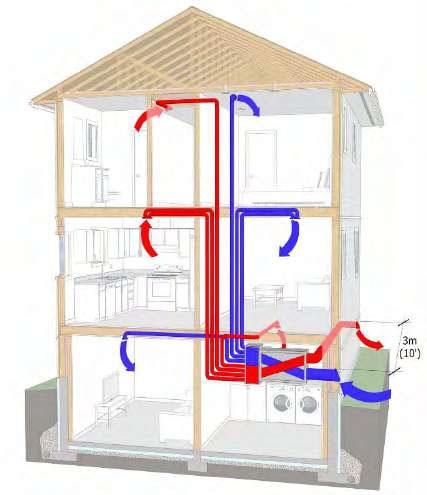Ventilation
Fresh Air for Healthy Homes:
A Guide to Ventilation for Home Builders in British Columbia
Building healthy and comfortable homes in British Columbia requires careful consideration of ventilation strategies. This guide explores the importance of ventilation, relevant building codes (BC Building Code – BCBC and National Building Code – NBC), and best practices for achieving optimal indoor air quality.
Why Ventilation Matters
Proper ventilation is crucial for maintaining a healthy living environment. It:
- Removes Pollutants: Cooking, showering, and breathing generate moisture and contaminants. Ventilation removes these, preventing respiratory problems like asthma and allergies.
- Maintains Good Air Quality: Fresh air is brought in, diluting indoor pollutants and creating a more pleasant atmosphere.
- Controls Humidity: Excess moisture can grow mould and damage your home. Proper ventilation helps regulate humidity levels.
Natural vs. Mechanical Ventilation
There are two main approaches to ventilation:
- Natural ventilation: This relies on opening windows and doors. While energy-saving, it’s not always reliable. Weather conditions can make it difficult to control airflow, and drafts can create discomfort.
- Mechanical ventilation: This uses fans and ductwork to control airflow. Mechanical systems offer consistent performance year-round.
Building Codes and Ventilation in BC
The BC Building Code (BCBC 2024) and Part 9 of the National Building Code (NBC) require all new houses in BC to have a mechanical ventilation system. These codes ensure a minimum level of fresh air for good indoor air quality.
BCBC Requirements:
Section 9.32: Requires a principal ventilation system to exhaust air from bathrooms and kitchens and supply fresh air to bedrooms and living areas.
Section 9.36: Requires a continuous air barrier to improve energy efficiency. A tighter enclosure necessitates a mechanical ventilation system for adequate air exchange.
While the BC Codes 2024 took effect on March 8, 2024, some specific changes related to adaptable dwellings and earthquake design were deferred to March 10, 2025. The key takeaway for ventilation in single-dwelling units remains unchanged.
Balanced Mechanical Ventilation: The Preferred Approach
Balanced mechanical ventilation systems are the most effective method to meet code requirements and achieve optimal indoor air quality. They use fans to:
- Exhaust stale air: Air from kitchens, bathrooms, and laundry rooms is removed.
- Supply fresh air: Filtered outdoor air is brought into bedrooms and living areas.
Benefits of Balanced Ventilation:
- Improved Indoor Air Quality: Consistent removal of pollutants and introduction of fresh air.
- Energy Efficiency: Minimizes energy loss compared to exhaust-only systems.
- Comfort: Prevents drafts and provides consistent temperature control.
- Reduced Risk of Moisture Problems: Balanced ventilation helps regulate humidity levels.
Heat Recovery Ventilators (HRVs) and Energy Recovery Ventilators (ERVs):
HRVs and ERVs are advanced balanced mechanical ventilation systems that offer additional benefits:
- Heat Recovery (HRV): In cold climates like BC, HRVs capture heat from exhaust air and transfer it to incoming fresh air, reducing heating costs.
- Energy Recovery (ERV): ERVs go a step further, recovering moisture from exhaust air and transferring it to incoming air. This helps maintain comfortable humidity levels, which is particularly beneficial in drier periods.
HRVs and ERVs: A Smart Investment for BC Builders
While HRVs and ERVs may have a slightly higher initial cost compared to basic ventilation systems, the long-term benefits are significant:
- Improved Indoor Air Quality: A healthier living environment for your clients.
- Energy Savings: Reduced heating and cooling costs.
- Increased Comfort: Consistent temperature and humidity control.
- Durable Home: Reduced risk of moisture damage from condensation.
Balanced ventilation systems can include:
Furnace/Air Handler Integration: The furnace fan draws outdoor air with an outdoor air duct connected to the return. This should be interlocked with a central exhaust fan for simultaneous operation. While potentially functional, this approach can be more challenging to design and install compared to a dedicated HRV/ERV. Furnaces with energy-efficient brushless DC motors are recommended for this setup.

HRV/ERV as a Standalone System: Continuously removes stale air from specific rooms and supplies fresh air to others through dedicated ducts. Fully ducted systems are completely separate from the space heating or cooling system and include separate ductwork for supply and exhaust distribution. If used with a furnace system, the HRV/ERV will typically be interlocked with the furnace so that the furnace fan operates when the HRV/ERV does.

HRV/ERV as a Standalone System: Another option is to use home run ducting, in which each grille/diffuser is connected to one or more dedicated ducts that run directly to and from the HRV/ERV unit. Balancing is relatively simple since each duct is connected to only one diffuser or diffuser box. Fine-tuning of airflow can be done by adjusting the nozzle of the supply diffuser. A mixing box is required between the ducts and the HRV/ERV unit to gather the air entering and leaving the main supply and return openings.

Conclusion
By incorporating balanced mechanical ventilation systems, particularly HRVs and ERVs, into your new home builds, you’ll be offering your clients a valuable investment in their health, comfort, and energy efficiency. This aligns perfectly with the BCBC and NBC’s focus on healthy and sustainable building practices.
Additional Resources:
BC Building Code: https://www2.gov.bc.ca/gov/content/industry/construction-industry/building-codes-standards/bc-codes/2024-bc-codes

